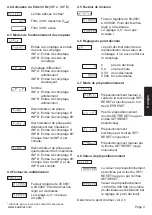
Page 4
www.kuebler.com
4.3 Multiplying factor
It can be set from 00.0001 up
to 99.9999.
The decimal point is set to 4
decimal places.
„0“ is not accepted!
4.2 Switching on the 30 Hz filter
The filter provides input
damping*
30 Hz filter off (f
max
)
30 Hzfilter on
It can be set from 00.0001 up
to 99.9999.
The decimal point is set to 4
decimal places.
„0“ is not accepted!
4.4 Dividing factor
4.6 Display mode
Value conversion and
display in 1/s
Value conversion and
display in 1/min
4.7 Max. time to wait until „0“ is displayed
This parameter indicates, how long it takes, when
measuring is active, until „0“ is displayed.
Max. time to wait 00.1 s
(min. value)
Max. time to wait 99.9 s
4.8 End of programming
The programming routine is
repeated once more. The
values set until now can be
checked and modified.
The programming routine will
be left and all values set will be
stored as new parameters.
Afterwards the device is ready
for operation.
4.1 Polarity of the inputs
npn: switching for 0 V
pnp: switching for +U
B
4. Programming routine
The programmable parameters of the device are
described below, in the order in which they can
be set. The device is fully programmed after one
pass of the routine.
The first values stated correspond to the
factor settings.
4.5 Decimal point
The decimal point defines the
resolution in the selected mea-
suring range 1/min or 1/sec
0
no decimal place
0.0
one decimal place
0.00 two decimal places
0.000 three decimal places
Time meter Codix 523
(Codix 524: Operating mode time meter)
1. Description
• 6 digit time meter with SET/RESET function
• Red LED display, character height 8 mm
• Display range from 0 to 999 999
• Leading zeros suppression.
• Operation indicator: the decimal point of the
lowest digit blinks while the count is active.
• Programming via two setting keys on the front
side
• During programming, the display guides the
user with text prompts
• Time meter operating modes
– Counting while INP B is inactive (GAtE.Lo)
– Counting while INP B is active (GatE.hi)
– Count Start/Stop with INP B edge (Inb.Inb)
– Count Start with INP A edge, count Stop with
INP B edge (InA.Inb)
* where bounce occurs, e.g. with contacts













































